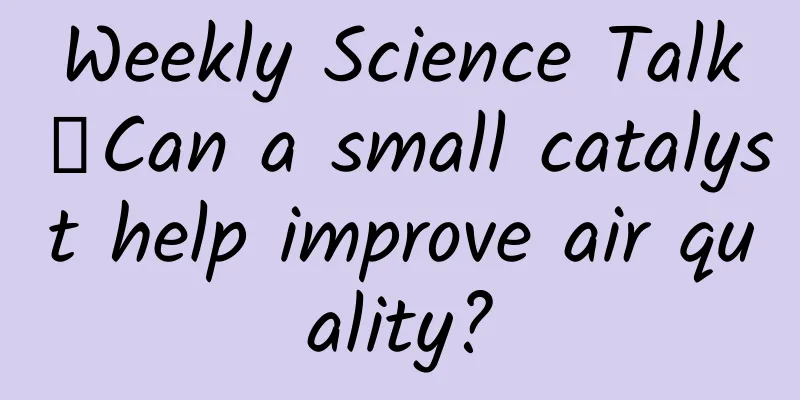Weekly Science Talk丨Can a small catalyst help improve air quality?

|
In August, the Ministry of Ecology and Environment reported to the media the national ambient air quality situation. From January to August, the average proportion of days with good air quality in 339 cities at prefecture level and above was 83.2%, and the average concentration of PM2.5 was 29 micrograms per cubic meter, up 3.6% year-on-year and down 17.1% from the same period in 2019. Do you feel that the air quality has improved in recent years? Especially those living in the north can clearly feel that there are more blue skies. Take Beijing as an example. Blue sky is no longer a "luxury". There are more and more good days. In 2022, there were 286 days with good air quality, 110 days more than in 2013. In other words, there were nearly 4 more months of good days. Generally speaking, the main culprits for air quality problems are: fine particulate matter (PM2.5), sulfur dioxide (SO2), nitrogen oxides (NOX), carbon monoxide and other atmospheric pollutants. To govern the atmosphere, we must start with these pollutants. Looking back at the prevention and control of atmospheric pollutants in recent years, we will find that the concentrations of PM2.5 and SO2 in the air have dropped significantly, but in comparison, the decline in NOX has not been so fast. According to the "Special Edition of the 2022 China Atmosphere Report", from 2011 to 2022, China's total SO2 emissions fell by 86%, while NOX fell by only about 58%. In other words, there is still a lot of room for NOX to fall. Why are NOX emissions more difficult to control? First of all, the source of NOX is more complicated than that of SO2. SO2 emissions mainly come from fixed sources, such as coal-fired power plants and industrial boilers, but NOX emissions also come from a mobile source - automobile exhaust. As a result, scientists have to study different NOX pollution control technologies to suit different scenarios. On the other hand, the NOX pollution control technology, also known as the selective catalytic reduction (SCR) denitrification technology, was applied later than the SO2 desulfurization technology. The application of SCR in different fields and industries also faces some problems. For example, in thermal power plants, SCR faces a dilemma: the combustion of coal and oil will release a large amount of smoke. If the SCR is arranged before the dust removal, the smoke will easily clog the catalyst and affect the efficiency of NOX removal. If the dust is removed first and then the SCR is arranged, the temperature of the flue gas will be relatively low and will not be within the active temperature range of the SCR technology catalyst. In industries such as ceramics and glass, there are alkali metals or heavy metals in industrial waste gas, and the SCR catalyst is easily poisoned and loses its activity. It is not difficult to see that catalyst is a key link in SCR technology. Existing catalysts cannot cope well with low temperature, smoke, or metal poisoning. However, Chinese scientists are also working hard to overcome this difficulty. Among them, the "Basic Research on Catalytic Purification of Nitrogen Oxides in Combustion Exhaust Gases" chaired by He Hong, an academician of the Chinese Academy of Engineering and deputy director of the Eco-Environmental Research Center of the Chinese Academy of Sciences, has designed a series of new catalysts that can effectively improve the activity of catalysts in low temperature zones. The research won the second prize of the National Natural Science Award in 2019. After in-depth research on catalytic reactions, the researchers have refined an efficient catalyst design principle, namely the principle of tight coupling of catalyst oxidation/reduction sites and acidic sites. Simply put, in a catalytic reaction, both redox sites and acidic sites are needed. During the design, these two sites need to be tightly coupled together so that the reaction can occur smoothly. For the same type of site, for example, if they are all redox sites, it is best to be highly dispersed on the surface of the catalyst to allow the catalytic reaction to occur over a larger area. Under this design principle, He Hong's team developed a series of new catalysts that perform better at low temperatures. Among them, the vanadium-based catalysts improved under the guidance of He Hong's team have been applied to industrial scenarios and installed on the exhaust purifiers of heavy-duty diesel vehicles, successfully reducing the nitrogen oxide emissions of diesel vehicles by more than 70%. It is believed that in the future, with further research on catalysts and the industrial promotion of research results, controlling nitrogen oxide emissions in the atmosphere will no longer be a problem. Author: Fan Kexin, Master of Imperial College London Gatekeeper: Zhu Yehua, deputy editor of Science and Technology Herald
Xinhuanet Co-production |
Recommend
Guiyang SEO Training: How can SEO novices avoid optimization mistakes?
How can SEO novices avoid optimization misunderst...
Comic: The flowers are so beautiful that they dazzle your eyes. Let us help you recognize the "spring flowers" with wisdom.
During the Qingming Festival, the sun is shining ...
Profitable customer acquisition methods for K12 online education!
In 2019, the author participated in the cold star...
Aion V (Tyrannosaurus Rex) opens its doors for the first time, with eight leading product strengths shaping a new global classic
On June 20, Aion's first global strategic mod...
It has a detachable butt, and a brain on its butt! | Natural Trumpet
Welcome to the 48th issue of the Nature Trumpet c...
How to improve users’ acceptance of advertising? Here are 7 techniques!
Those great advertisements often come from the bra...
11 ways to make money suitable for novices. Just stick to the operation and you can earn over 10,000 yuan a month!
1. Earn money by completing tasks This is very co...
In-depth | How to start new media operations without a budget?
How to start new media operations without a budge...
Will artists be replaced in the AI era? 丨AIGC New Career Observation
Can AI become the “Ma Liang’s magic brush” that c...
This small hole on the ear is not a symbol of "wealth"! It may be a dangerous hole...
This article was reviewed by: Xiaobo Zhou, Doctor...
The PC version of TikTok is here. What is the experience of using TikTok on your computer?
Tik Tok has launched a PC version. We can happily...
Pass the four major NSCA certification courses
: : : : : : : : : : : : : : :...
How to restore physical strength during the recovery period? Expert answers!
How to use medicine scientifically after infectio...
Why is Weibo becoming a standard “must-buy” marketing channel for advertisers?
On August 9, Beijing time, Weibo’s stock price re...
Domestic brands are making a comprehensive attack from technology to products, and the large-screen TV industry has overcome the darkest moment in 2021
Suffering from lack core Due to the impact of pan...









